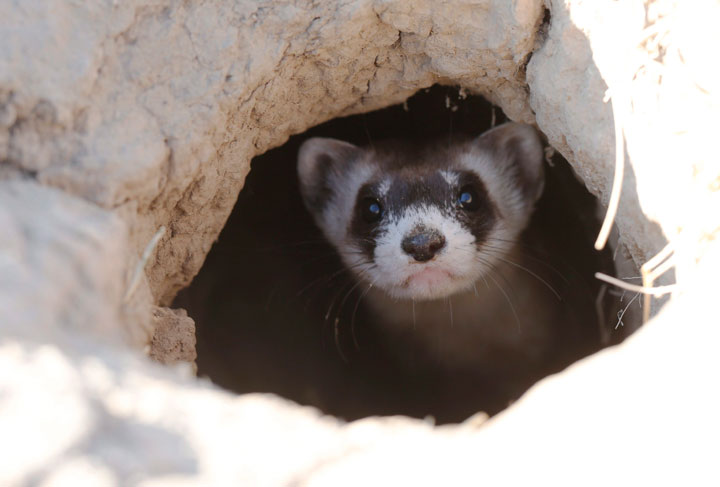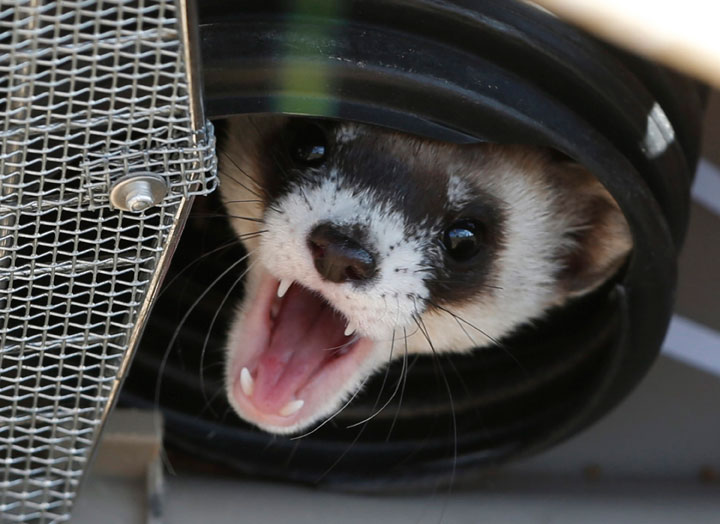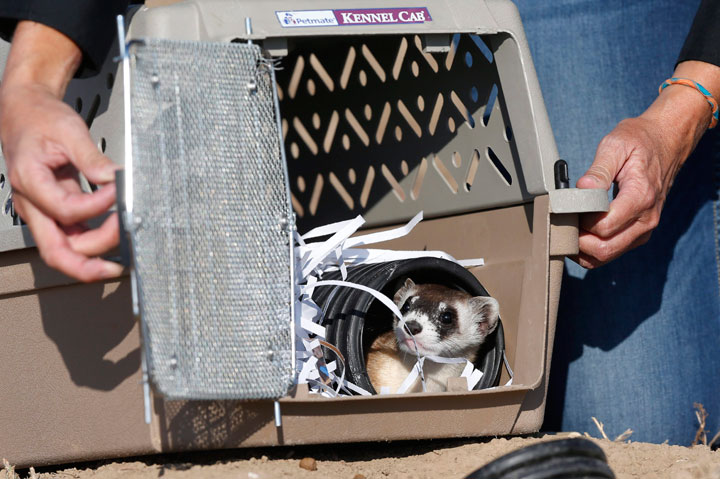CHEYENNE, Wyo. – Feeding peanut butter kibbles to millions of prairie dogs – by flinging the treats from four-wheelers and dropping them from drones – could be the next big thing to help a spunky little weasel that almost went extinct.

Slinky with a robber-like black mask across its eyes, the endangered black-footed ferret is a fierce predator. The up to 2-foot-long weasel feeds almost exclusively on prairie dogs, rodents that live in vast colonies regularly decimated by plague outbreaks.
The disease keeps threatening the food supply of ferrets bred in captivity and reintroduced on the landscape. Biologists are increasingly optimistic that feeding plague vaccine to prairie dogs can improve the ferrets’ success rate.
Starting this fall, they hope to ramp up recent plague vaccination experiments to cover as much as 40 square miles of prairie dog colonies in several states in the West.
“We’re not attempting to eradicate it. That would be very, very difficult at this point. We’re just trying to manage it on selected colonies,” said Tonie Rocke, who researches animal diseases with the U.S. Geological Survey’s National Wildlife Health Center in Madison, Wisconsin.
They plan to treat prairie dog colonies with blueberry-sized vaccine pellets made with peanut butter, using a specially made “glorified gumball machine” to fling the pellets from all-terrain vehicles. They might also drop pellets from drones to avoid trampling the countryside.

Get breaking National news
“Prairie dogs love it. They gobble it up as fast as they can,” said John Emmerich, a retired Wyoming Game and Fish Department deputy director who chairs Black-Footed Ferret Friends, a group working with the U.S. Fish and Wildlife Service on the project.
At a rate of 40 to 50 pellets per acre, Emmerich figures they will need 1 million or more pellets for the job. A U.S. Department of Agriculture supply depot in Pocatello, Idaho, that also makes rodent poison for farmers will manufacture the pellets.
Fighting the plague
Plague, which killed millions of people in medieval Europe, wasn’t a problem for prairie dogs until it arrived in the U.S. over a century ago. The disease now routinely cycles through prairie dog colonies across the ferrets’ 12-state historical range.
Habitat loss to farming and poisoning by ranchers also has taken a toll on prairie dogs – and by extension the black-footed ferret, which lives in the rodents’ burrows. The ferrets were believed extinct until a ranch dog brought home a dead one near Meeteetse, Wyoming, in 1981.
Beginning in the 1990s, efforts to breed black-footed ferrets at a facility near Fort Collins, Colorado, and release them into the wild have been successful in the sense that the black-footed ferret is no longer teetering on the brink.
Black-footed ferrets recently have been introduced at the Rocky Mountain Arsenal National Wildlife Refuge near Denver and to the Meeteetse ranch where scientists collected the last known wild ferrets to start the captive-breeding program. Descendants of those ferrets have been reintroduced at 28 sites and eight states, Canada and Mexico.
But plague, which is spread by fleas, remains a threat to the prairie dog colonies where ferrets live, said Fish and Wildlife spokesman Ryan Moehring.
Biologists often treat the colonies with insecticide to combat fleas. Plague vaccine likewise would need to be applied regularly – once a year, because prairie dogs typically don’t live more than a few years, and new ones are born every year. But the vaccine could require a lot less work, especially if drones are used.
An estimated 300 black-footed ferrets now live in the wild. Getting them off the endangered list would require establishing 3,000 or more breeding adults on half a million acres – 780 square miles – of prairie-dog colonies, according to Fish and Wildlife.
The vaccine could help put that goal within reach.
“We’ll see as we expand the acreage, and see how it performs, but I think so far the results are promising,” Moehring said.




Comments